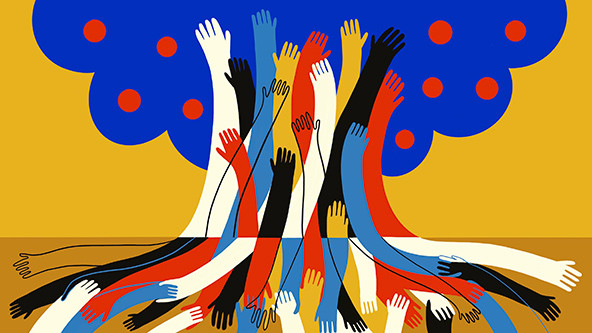 (Illustration by Helena Pallarés)
(Illustration by Helena Pallarés)
At a 2017 event hosted by The Wellbeing Project (TWP), Gabriela Gandel, executive director of the social entrepreneur network Impact Hub, expressed the need to address dysfunction and high rates of burnout across the social change sector, through the development of well-being at the organizational level. Her comments resonated with everyone in the room and led TWP to engage with hundreds of people who echoed a desire to learn how social change organizations can develop well-being initiatives.
We continue to hear a strong desire for greater organizational well-being in the social sector, but the need is also plain to see. Institutional dysfunction has been making headlines globally for years, most recently in a series of open letters to the board of Planned Parenthood. The letters outline how financial wrongdoing, abusive and discriminatory behavior, disregard for staff well-being, and a culture of silence has resulted in the erosion of accountability toward the organization’s mission and values.

Staff at Amnesty International also reported a toxic work culture, following an investigation into two suicides of staff members in 2018. Staff said that a lack of trust, bullying, abusive power dynamics, favoritism, discrimination, and secondary or vicarious trauma from the nature of their work contributed to high levels of stress. The investigation ultimately determined that organizational culture and management failures, coupled with unrealistic workloads, were the predominant cause of severely compromised staff well-being.
This kind of disconnection between values, purpose, and practice—along with organizational cultures that feed dysfunctional power dynamics, and deficiencies of accountability and transparency—cause havoc. They damage organizations, their dedicated staff, public trust, funding streams, and the overall reputation of the social sector.
So how can leaders begin to address these problems and foster a culture of well-being within their organizations? While our research on this topic is ongoing, preliminary findings suggest that supporting individual well-being—combined with well-tailored, incremental changes to structure, policy, practices, and communications—go a long way toward fostering healthier and more-effective organizational cultures.
The Power of Individual Well-Being
Previous articles in this series, Centered Self: The Connection Between Inner Well-Being and Social Change, have explored how the presence or absence of inner well-being for social change leaders influences how social change happens. Articles have examined the benefit of consistent self-inquiry in promoting inner well-being, the various ways funders can support the inner well-being of people involved in social change, and common critiques of well-being initiatives.
Our initial research revealed that enhancing inner well-being for individuals reduces burnout, enhances resiliency, and increases trust and open-mindedness. We also observed how changes for individuals produced ripple effects at the organizational level, including more openness to diverse perspectives and greater collaboration. These findings encouraged us to explore how supporting organizational well-being impacts individuals working for social change and social innovation across the sector. Although we believe any change we expect to see in the world begins with ourselves, organizational well-being is about more than taking individual well-being to scale. Rather, it’s influenced by interrelating individual, organizational, and societal factors, and subject to constantly shifting priorities in a complex global environment.
The Other Half of the Equation
Integrating well-being as a central part of organizational life has been largely unheard of until now. Typically, organizations focus on the external social problem they are seeking to solve, rather than their internal health. Behind the scenes, they can easily develop problematic perceptions and ways of working—including unchallenged assumptions and unresolved conflicts—that have wide-reaching impacts on staff and mission delivery.
In many cases, the prevailing “sacrifice for the greater good” culture that exists across the sector has simply rendered it less of a priority. Well-intentioned leaders and staff—particularly those who personally identify with the organization’s mission—often ignore signs of burnout or disregard unhealthy work practices. Even people interested in developing well-being may think it diverts too many resources away from mission. In other cases, leaders feel that taking action may be too difficult or not tailored to their organization’s specific needs. After all, organizational well-being is relatively unchartered territory; there is no “one size fits all” approach.
Putting the Two Together
In 2015, The Wellbeing Project ran an 18-month Inner Development Program (IDP) to support social entrepreneurs, activists, and nonprofit leaders whose work took a significant toll on their health and relationships. The program helped participants gain an understanding and orientation toward well-being that ultimately helped them adopt healthier patterns of living and working. Following the program, participants were eager to apply what they learned within their organization. At the same time, other social change leaders were requesting help; they needed research and resources for developing organizational well-being.
In response, The Wellbeing Project, along with eight other organizations, created a new, three-year Organizational Exploratory Program (OEP) that provides the scaffolding for participants to approach, initiate, and sustain experiments that enhance organizational well-being. Alongside the program’s facilitated in-person gatherings, peer learning, and other supports, there’s an emphasis on enabling participants to develop their own paths to well-being based on their unique organizational needs and contexts. They learn to look at things differently through active listening and working with staff, and by challenging perceptions and assumptions that may be preventing progress.
Importantly, the program includes one staff member from each organization that participated in the IDP. These leaders’ prior experience with “inner work” (developing a practice to promote their individual well-being) sets the stage for them to engage with staff, colleagues, and peers in a more open and collaborative way. It also helps them model commitment to well-being, and welcome and support healthier ways of working. Based on initial conversations with these leaders, the program focuses on the human-centered aspects of organizational life, emphasizing motivational factors such as belonging and cooperation to foster resiliency and sustainability. This approach aims to remove the organizational hypocrisy of seeking to improve the welfare and dignity of those outside the organization while ignoring what goes on inside.
At the beginning of the program, we introduced participants to management researcher David Snowden’s Cynefin framework as a method for social change organizations to frame and respond to the increasingly complex, unpredictable, and emergent realities they face. We also designed in-house experiments that allowed them to implement and monitor changes that were culturally appropriate for their organization, and in a safe-to-fail context. This laid the foundation for them to think about “microshifts”—the process of identifying and making small, incremental shifts to organizational structure, policy, practices, and communications, with the goal of enhancing organizational well-being
Finally, to address the short- and long-term consequences of stress on individual and organizational well-being, the program includes a focus on resilience, or our human capacity to recover from challenging circumstances.
Emerging Insights
Our research partners at The Tavistock Institute and the Center for Healthy Minds are leading a mixed-methods, iterative, participatory, research process to gather insights on the program. This includes supporting the organizations in describing their current culture of well-being; identifying barriers and supports for well-being; and documenting how attention to well-being impacts staff, mission delivery, and quality of work. Over the next two years, the researchers will provide participating organizations with a realistic, multi-perspective view of their organizational well-being, as well as information and tools for ongoing use.
Themes and learnings emerging from the first round of qualitative research include:
- Organizations can encourage and support organizational well-being without straining staff capacity or financial resources by integrating microshifts—small, incremental changes to organizational policies, communications and personal development procedures, and workflow management.
- Instead of following generalized programs or guidelines that work for other organizations or sectors, organizations should develop well-being initiatives that fits their unique cultural, political, and social sector contexts. An initiative that works for staff who experience vicarious trauma while working with indigenous communities, for example, may not be relevant to an organization that wants to reduce stress levels related to political upheaval and resulting financial challenges.
- Cultivating a deep sense of belonging promotes staff participation in decision-making and conflict resolution. Organization-wide meetings, transparent governance procedures, and opportunities to really get to know colleagues through reflection and check-in exercises all contribute to a culture of belonging.
- Developing the capacity to recognize, acknowledge, and revise structures that don’t support safety, diversity, and inclusion is essential to organizational well-being. Organizations can enlist expert support in the form of coaches, organizational development specialists, or workshop facilitators to help identify gaps and improve systems.
- Organizations need to move away from both the traditional, “heroic” leadership and “family values” approaches commonly associated with the social change sector, toward more systems-informed and self-aware structures that encourage everyone (not just those in senior positions) to take responsibility for the organization’s success. Finding ways to encourage dialogue between staff can help achieve shared understanding about issues and possible solutions.
- Developing capacities such as awareness and active listening helps organizations better cope with uncertainty, anticipate change, and foster institutional resilience and sustainability.
- Well-functioning, effective organizations integrate mission and well-being in order to effectively engage in social change over the long term. By engaging in inner work, individuals learn how to be healthier themselves and in their relationships, and are therefore more capable of creating healthier workplaces.
A Stronger Sector
Organizational well-being provides the scaffolding for people and organizations to adapt, grow, and flourish. But achieving it isn’t just about scaling individual well-being, and it requires more than stating values and guidelines in a human resources handbook. Organizations need to fit initiatives to their own unique characteristics and needs, and address both the “being” and the “doing” elements of organizational life. They must pay attention to how individuals approach their work and why they do it, as well as how their work is structured, and from there, work to integrate both parts of the equation. Microshifts can help speed progress and build the kind of human-centric, resilient staff and organizations the sector wants and needs. Small changes such as allowing time for deeper check-ins at the start of meetings, creating space to work through difficult conversations, collectively developing well-being plans for the organization, or integrating well-being into strategic planning can uproot unhealthy patterns and promote the emergence of healthier systems—whether organizational, sectoral, or systemic—over time.
During the next two years, we’ll continue to support participants as they integrate well-being within their organization, documenting the links between inner and organizational well-being and social impact. As more and more organizations commit to organizational well-being, our hope is that we’ll see more examples of resilience among individuals working in the sector, as well as improvements to institutional sustainability, collaboration, and long-term mission achievement.
Support SSIR’s coverage of cross-sector solutions to global challenges.
Help us further the reach of innovative ideas. Donate today.
Read more stories by Alana Cookman & Gayle Karen Young Whyte.

